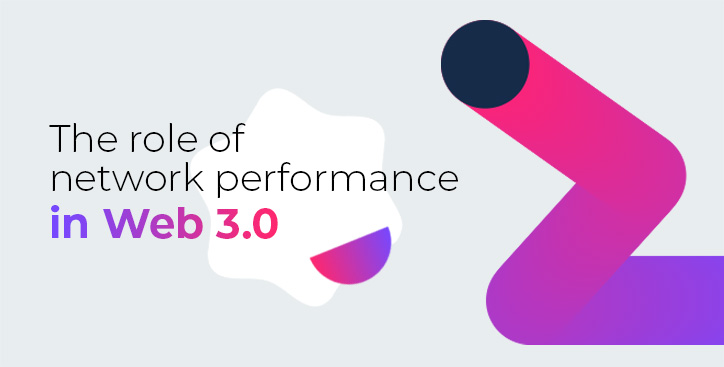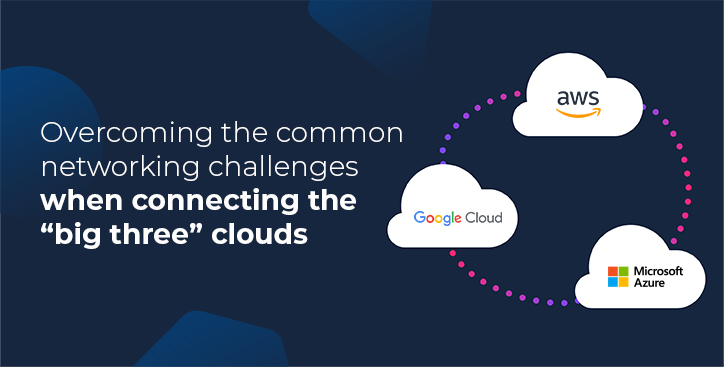How improved network performance is a key part of Web 3.0 delivery
By Alex Hawkes|11 September, 2023

Web 3.0 could see the emergence of more decentralized online ecosystem based on blockchain. In this blog, we examine the important role that network performance will play in the arrival of Web3 in order to reduce frustrations and shortcomings with the existing traditional public internet.
In this blog we look at the role network performance will play in the delivery of web 3.0.
What is Web3?
Web 3.0 is an emerging technological iteration of both the internet and the World Wide Web, heavily incorporating concepts including decentralisation, blockchain, and tokenisation.
There is a fair amount of debate and no concrete agreed upon definition, but on the infrastructure side, three fundamental architectural enablers of Web 3.0, or ‘Web3’ as it is known to some, are a combination of decentralised or federated platforms, secured interoperability, and verifiable computing through distributed ledger technologies such as those we see powering the blockchains used for cryptocurrencies.
The evolution of the World Wide Web
Web 1.0 refers roughly to the earliest days of the World Wide Web - from around 1989 to 2004, when most web sites consisted of a collection of static pages. Sites numbered only into the tens of thousands and the vast majority of users were consumers of this content, not producers themselves. Myspace came along towards the tail end of this era and marked a transition to Web 2.0.
Web 2.0 is generally considered to have begun around 2004 and continues to the present day. Its evolution is significant for the adoption of the idea of ‘the web as platform’ and the rise of social networks, which centre on user-created content, as well as a shift towards video-rich content such as YouTube, Instagram, and TikTok. During the past two decades the number of sites climbed quickly into the millions and we passed the one billion website mark in 2014. Of this only around 200 million sites are active however, with most being parked domains.
The arrival of Web3
With the arrival of the first blockchain in 2008, and the first real-world blockchain transaction on the Bitcoin network in 2010, it could be argued that this event marked the arrival of Web3. However, the technology and its adoption are still very much in their infancy even today.
The term ‘Web3’ was coined by Gavin Wood, co-founder of the Ethereum network along with Vitalik Buterin, in 2014. Although Ethereum has become the second largest cryptocurrency after Bitcoin by market capitalisation its versatility has driven innovation in crypto far more than any other network.
Wood went on to found the Polkadot blockchain platform in 2020 with a focus on enabling interoperability between a wide range of blockchains, which is a core tenet of his vision of Web3 as a "decentralized online ecosystem based on blockchain." These moves towards interoperability is where we are seeing most innovation today.
Decentralisation for the masses
One of the core drivers for the adoption and development of Web3 is a concern that data, content, and therefore control of the web has been concentrated or centralised with a small group of companies often referred to as ‘Big Tech’.
This group typically includes reference to some of the largest Web 2.0 players including Google/Alphabet, Amazon, Microsoft, and Facebook/Meta, the first three of which also control the lion’s share of the cloud infrastructure market.
As a method of breaking this oligopoly, Web3 seeks to decentralise control and introduce greater flexibility and efficiency. Some argue that such a transition would reduce the privacy risks and business challenges associated with the current oligopoly, as well as drive a sharp decline in end user prices as applications and platforms are not controlled by a small number of entities but are free to leverage multiple previously underutilised infrastructure nodes in a network.
One of the arguments to this effect highlights the overly complex pricing schemes that have become so commonplace among cloud platform providers, where dozens of available options require the use of on-site pricing calculators to help customers navigate the menu, while still obfuscating egress fees and API call costs that give so many enterprises bill shock.
On the flip side, others argue that adoption of a blockchain-based internet would only push control towards the venture capitalists and investment firms backing many blockchain vehicles, resulting in a re-centralisation of control not dissimilar to what we’ve seen with Web 2.0.
Adoption of blockchain in networking
But regardless of whether the future of Web3 lies with one direction or another, blockchain technology is already being adopted by the networks and network operators that make up the internet today.
With the rise of network automation, service assurance, billing and settlement become more complex, because parameters are changing within the contract itself, which is something that blockchain lends itself to very well.
A blockchain is a cryptographically secured decentralised database or public ledger that accurately records information where no one entity has the power to manipulate the data. This means the information stored on the chain can be trusted by all participants in the network.
Using the distributed ledger technology with smart contract capabilities, a group of carriers could completely automate provisioning, billing and settlement between themselves.
The Communications Business Automation Network (CBAN) is one such forum of network operators. CBAN has spent several years developing proofs of concept and commercially launched a distributed ledger technology for inter-carrier settlement in 2022.
The ordering transaction itself is recorded on the ledger along with the smart contracts between participating carriers, with inter-carrier service level parameters captured in real-time compared with typical predefined SLAs.
Improving latency and throughput on the public internet through decentralisation
Another way decentralisation technology is making waves in connectivity is through route optimisation to reduce latency and improve throughput on the public internet.
One of the biggest frustrations for companies participating in the global digital economy - at least as far as Web 2.0 goes - is a reliance on the traditional public internet, which is a weak link for traffic because vector pathing is managed by BGP and is beyond the control of any single entity.
Syntropy, a network solutions business building a decentralised data availability layer using blockchain, is developing a fully programmable global digital fabric that runs on top of the public internet and creates a network of the best connected ISPs to ensure optimum performance through significant reductions in latency and packet loss, and significant improvements in network throughput.
The Syntropy Relay Network makes use of DARPs - distributed nodes (Distributed Autonomous Routing Protocol) - that continuously share latency information, creating a global intelligence layer for Internet pathways, relaying network traffic when they are able to provide a superior route versus the default public Internet path decided by BGP.
For digital businesses using its network, Syntropy reduces risk inherent to global network transit by putting the control back into the hands of the network operator, removing the limitations of internet protocols such as BGP and optimising throughput in complex environments with multiple data centres and cloud providers.
Real world improvements delivered by Syntropy
In a real world deployment of the Syntropy Relay Network, Console Connect delivered a bundle of nodes and network connectivity and Syntropy installed its DARP application on the nodes.
The DARP network overlay acts as a route optimisation system to find the best
Internet path: users of the Syntropy Relay Network send requests to all nodes to detect which node is the best Internet path option to use at the time of the request.
The Console Connect provided nodes were algorithmically selected to be deployed on the worst performing routes and Syntropy saw a median latency improvement per relay of 18.6ms, versus an improvement of 10.4ms in a non-Console Connect node.
Console Connect nodes were also able to reduce packet loss an entire percentage point, from a pre-existing 1.66% down to 0.067%, versus an improvement of only 0.22% points, from 0.23% to 0.013% for non-Console Connect nodes.
Leveraging Console Connect’s global network, Syntropy is able to demonstrate the route around critical failures, removing bottlenecks and limitations of the existing BGP system and unlocking greater scalability potential for future technologies and applications.
What this means is, existing Web 2.0 applications could leverage networks like Syntropy to optimise pathing and ensure high availability and resilience, for an enterprise accessing a mission critical cloud app, for example.
Native Web3 apps on the other hand could benefit from the features above as well as enhanced privacy and resilience, no censorship, and data authenticity as a result of being natively decentralised, putting more control in the hands of the application operators.

.jpg)





.jpg)

